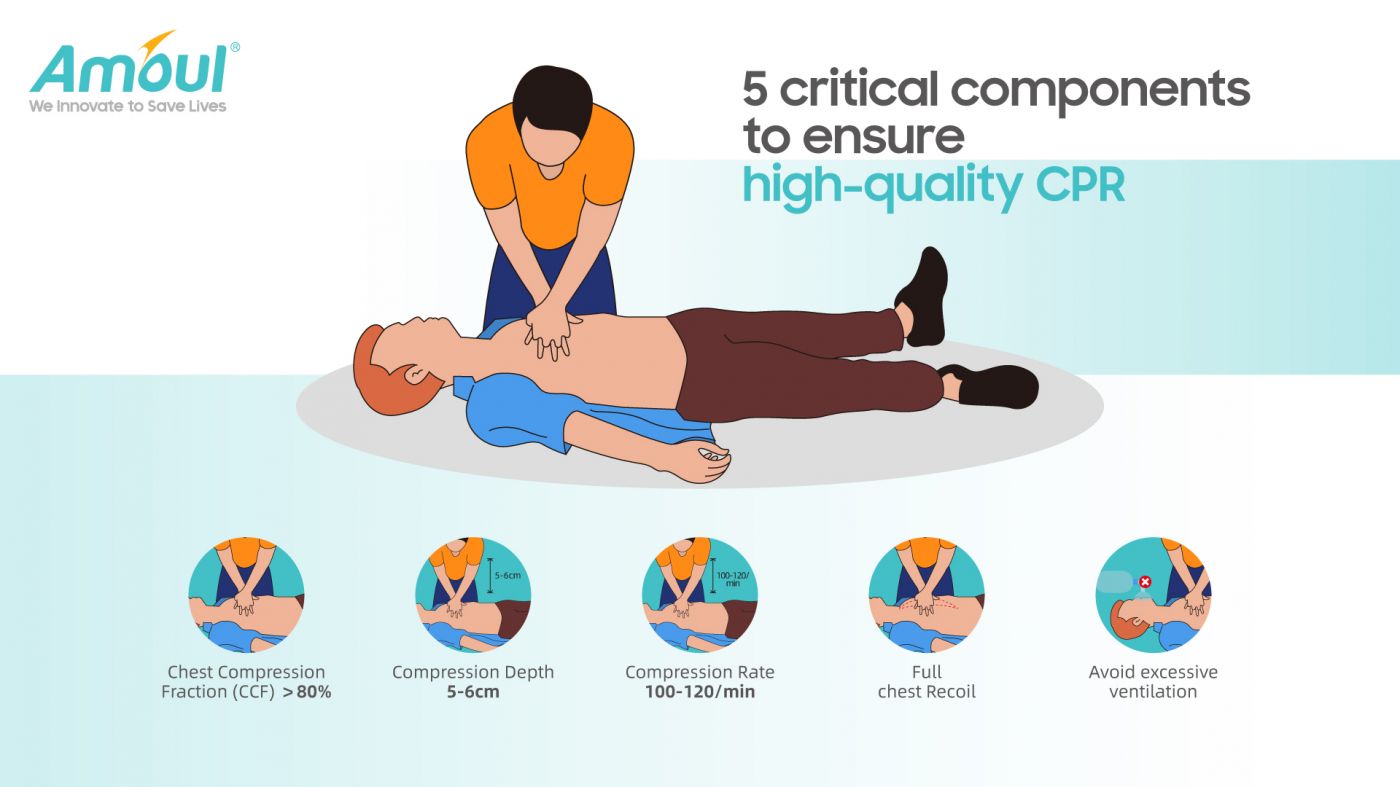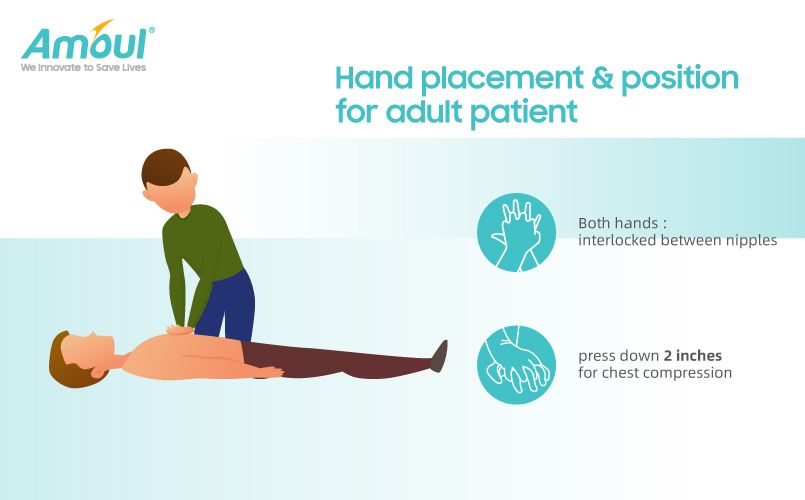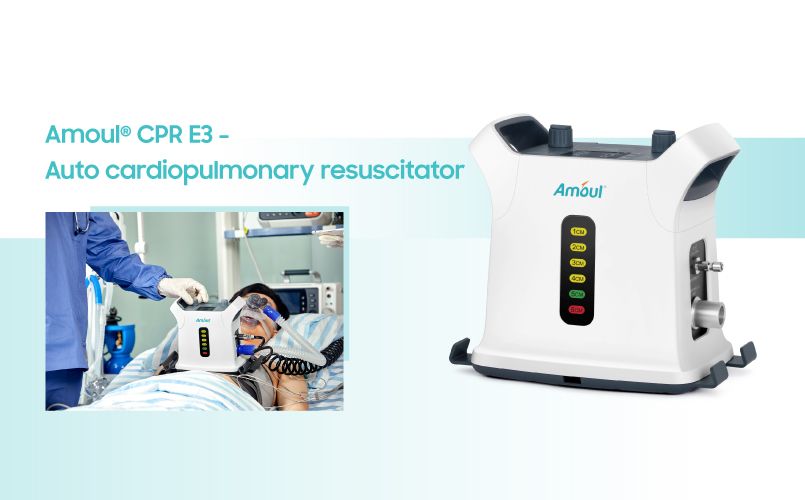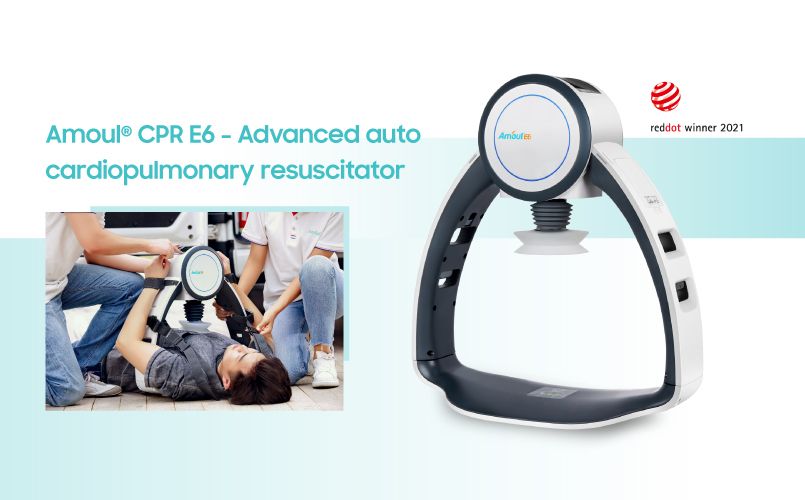

A person can be kept alive by doing cardiopulmonary resuscitation (CPR), which is done when their heart stops beating, or they start having breathing problems. In the event of a cardiac emergency or another life-threatening medical emergency, the only way to keep them from dying and hopefully save their life is by administering CPR because CPR can keep oxygenated blood flowing to the brain and other vital organs until more advanced medical help arrives.
High-quality CPR is cardiopulmonary resuscitation that meets performance metrics set by the American Heart Association (AHA) for improving survival from cardiac arrest. It means more than just getting the correct sequence of chest compression and forced breath. It also involves monitoring a victim's status throughout the entire process, in addition to being able to recognize when someone has stopped breathing and needs help. And the return of spontaneous circulation (ROSC) might be considerably increased from 42% to 72% by adhering to AHA-recommended guidelines [1].
Resuscitation is the process of restarting a person's circulation when their heart stops beating immediately. This could happen for a variety of reasons, but sudden cardiac arrest (SCA) is the leading cause of unexpected death in the United States, Canada, and other industrialized nations. SCA is the most frequent result of a heart attack when blood flow to the body is ceased, and the heart is unable to beat on its own. Cardiopulmonary resuscitation (CPR) and automated external defibrillation (AED) are life-saving techniques that can be performed by anyone to help someone who has suffered sudden cardiac arrest until emergency medical services arrive with further treatment.
According to the American Heart Association, more than 350,000 out-of-hospital cardiac arrests occur annually in the United States. Statistically, only about 12 percent of people who experience an out-of-hospital cardiac arrest survive [2]. When a person experiences cardiac arrest, their chances of survival drop 10% within every minute that passes before they get AED and CPR effectually.
During the emergency rescue, high-quality CPR involves uninterrupted chest compression with an effective chain of response that doubles or triples the chance of survival after cardiac arrest. In other words, it's a supply of continuous chest compression at an appropriate depth and rate with correct hand placement or device application, along with adequate breaths to help keep blood flowing throughout the body. That's why high-quality CPR is so important to save people's life.
In the 2020 Guidelines for CPR & ECC from American Heart Association (AHA), they define 5 critical components to ensure the delivery of high-quality CPR to victims of heart failure [2][3]. It's advantageous to understand well the consequence, and the correlation among these 5 main components applied to the practical rescue.

- Minimize interruptions in chest compression: CCF > 80%
Chest compression fraction (CCF) is defined as the amount of time spent performing chest compression during a cardiac arrest event.
AHA suggests performing chest compression at least 80% of the time CPR [3]. It has been shown that improving the CCF to more than 80% increases the survival rate from 200% to 300%[4]. And only minimal chest rise and a rate of < 12 breaths per minute.
- Provide chest compression rate from 100 to 120/min
AHA research demonstrated that effective Basic Life Support (BLS) requires a chest compression rate of 100 to 120 beats per minute. For the pediatric patient, give them 15 chest compressions followed by 2 breaths without advanced airway; for the adult patient, give them 30 chest compressions followed by 2 breaths without advanced airway.
- Chest Compression Depth customized for various patients
AHA advises that compression depth of a minimum 2 inches (50 mm) in adults, 2 inches (5 cm) in children, and 1½ inches (4 cm) in infants. More concretely, the optimal compression depth is affected by factors such as patient size, compression rate, and environmental features.
- Full chest recoil: No Residual Leaning
Connected to chest compression depth, full chest recoil is crucial to preserving proper blood flow to the brain. However, studies show that most rescuers often lean during CPR and do not allow the chest to recoil fully, thus reducing the effectiveness of the compressions.
- Avoid excessive ventilation
Excessive air volume could result in complications that lower the quality of CPR. AHA Guidelines for CPR & ECC recommend a ventilation rate of <12 breaths per minute to minimize the impact of positive-pressure ventilation on blood flow.

Hand placement & position for adult patient
Steps of performing CPR on adults:
1. Place the patient on their back and kneel next to them.
2. Place the heel of your hand on the lower half of the breastbone at the center of their chest, place your other hand on top of the first hand and interlock your fingers.
3. Position your shoulders directly above your hands. Use your body weight (not just arms) and keep your arms straight, and press straight down by 5 to 6 cm (2 to 2.5 inches) on the victim's chest.
4. Keep your hands on their chest, release the compression and allow their chest to return to its original position.
5. Repeat the compression at a rate of 100 to120 beats per minute at a rate of 100 to 120 beats per minute until the person starts breathing or an ambulance arrives.

Hand placement & position for child patient (> 1 year old)
Steps of performing CPR on children:
1. Open the children's airway by placing 1 hand on their forehead or top of the head and your other hand under the chin to tilt gently the head back. Remove any visible obstructions from their mouth and nose.
2. Pinch the soft part of their nose closed with your index finger and thumb. Take a breath and place your lips over the child's mouth, blow steadily into their mouth for about 1 second, check their rise of chest.
3. For children over 1 year old, place the heel of one hand on the center of their chest and push down by 5 cm (2 inches), which is approximately 1/3 of the chest diameter, use two hands if you can't achieve a depth of 5 cm using one hand; for children under 1 year old, place two fingers in the middle of the infant's chest and push down by 4 cm (about 1.5 inches), which is approximately 1/3 of the chest diameter, use the heel of one hand if you can't achieve a depth of 4 cm using the tips of 2 fingers.
4. Give them 2 breaths after every 15 chest compressions at a rate of 100 to 120 beats per minute.
5. Repeat with cycle of 15 chest compressions and 2 rescue breaths until the child start breathing or an ambulance arrives or for as long as you can.

Hand placement & position for infant patient (>1 year old)
With the help of Amoul® innovative technology, the cardiopulmonary resuscitation process might be facilitated and simplified by automatically administering chest compression and preventing interruptions from ensuring blood flow is delivered to critical organs. At present, mechanical CPR is an ideal solution for assisting rescuers in delivering high-quality CPR without physical fatigue and mental pressure.

Amoul® CPR E3 - Auto cardiopulmonary resuscitator
Amoul® CPR E3 is a unique combination of compression and ventilation for enhancing the effect of resuscitation. A small portable device with a compact design is simple and convenient for out-of-hospital cardiac arrest (OHCA) and application in ICU. Amoul® CPR E3 provides all-around 3D compression to ensure high-quality chest compression and decrease the harm as much as possible. Using a visible compression depth window to understand the real-time situation and adjust the compression in time. Five modes contain continuous compression, interrupted compression (15:2 & 30:2), continuous ventilation, and manual ventilation could be switched according to the patient's need. Continuously adjustable tidal volume from 100ml to 1500 ml improves the oxygenation while delivering breaths to the patient.

Amoul® CPR E6 - Advanced auto cardiopulmonary resuscitator
As the Reddot award winner product in 2021, Amoul® CPR E6 has been recognized globally as a high-performance medical device to improve the quality of cardiopulmonary resuscitation and increase the efficiency of rescue work. The design concept of CPR E6 was inspired by simulating manual CPR (the working mechanism of chest pump and heat pump), which provides smoothly continuous chest compression in the manner of electrical drive and electrical control.
It's simple and easy to start the rescue operation by using Amoul® CPR E6 3.5" HD touchable screen interface, including automatic positioning, automatic depth adjustment, one key setting, and CPR guidance. Equipped with two rechargeable batteries and support online charging function, ensure long rescue operation without interruption. The optional CO2 measurement function is favorable for checking the efficacy of chest compression.
High-quality CPR has been proven to be the most efficacious way of preventing sudden cardiac death because high-quality CPR involves uninterrupted chest compressions and having an effective chain of response when an individual goes into cardiac arrest. A standard of high-quality CPR helps us to ameliorate the effect of manual CPR verified by the American Heart Association. New technologies integrated into mechanical CPR adhere to the High-quality CPR criterion, which is technical progress in saving more people's lives.
1. CPR Quality: Improving Cardiac Resuscitation Outcomes Both Inside and Outside the Hospital. Peter A. Meaney, Bentley J.Bobrow, Mary E. Mancini, Jim Christenson, Allan R.de Caen, Farthan Bhanji, Benjamin S. Abella, Monica E. Kleinman, Dana P.Edelson, Robertt A. Berg,
Tom P.Aufderheide, Venu Menon, Marion Leary. 25 Jun 2013.
Available at: https://www.heart.org/-/media/data-import/downloadables/d/4/6/manuscript-cpr-quality-ucm_452301.pdf
2. 2020 American Heart Association Guidelines for CPR and ECC. American Heart Association.
Available at: https://cpr.heart.org/en/resuscitation-science/cpr-and-ecc-guidelines
3. High-Quality CPR. American Heart Association.
Available at: https://cpr.heart.org/en/resuscitation-science/high-quality-cpr
4 . 2015 Guidelines BLS ILT Course FAQ. American Heart Association. 18 Jan 2018.
Available at: https://cpr.heart.org/-/media/cpr-files/course-faqs/bls-ilt-faq_updated-11818.pdf?la=en
5.How to perform CPR ? Health direct.
Available at: https://www.healthdirect.gov.au/how-to-perform-cpr